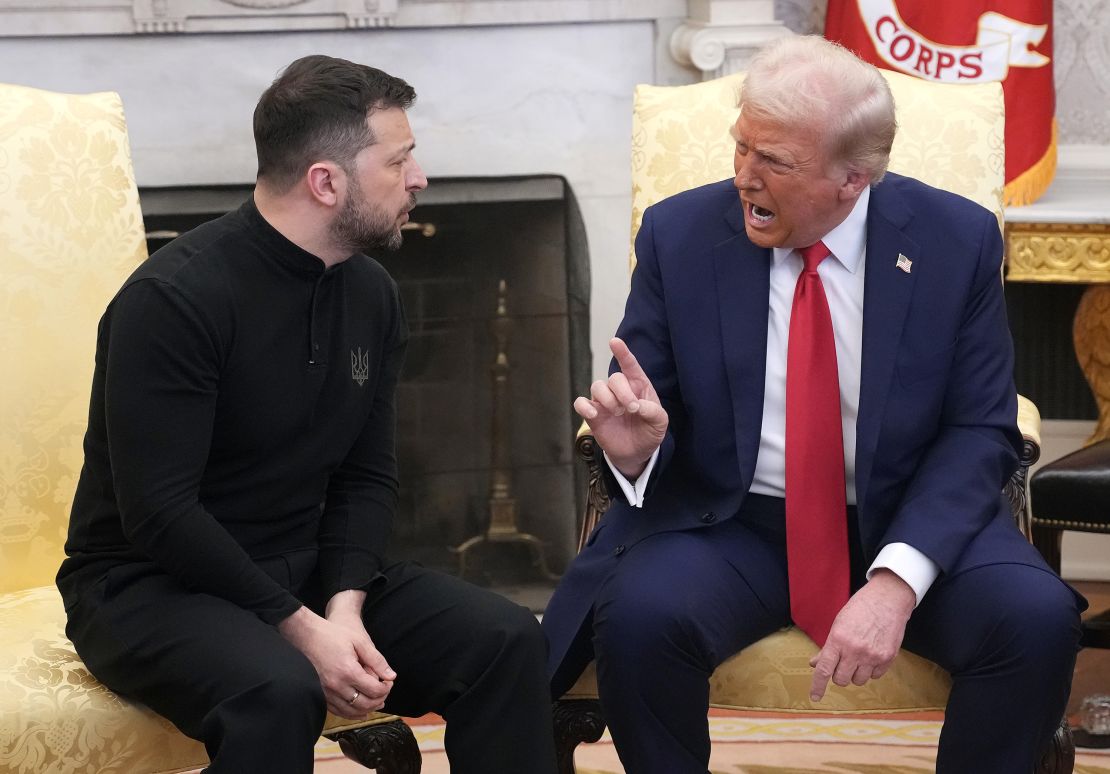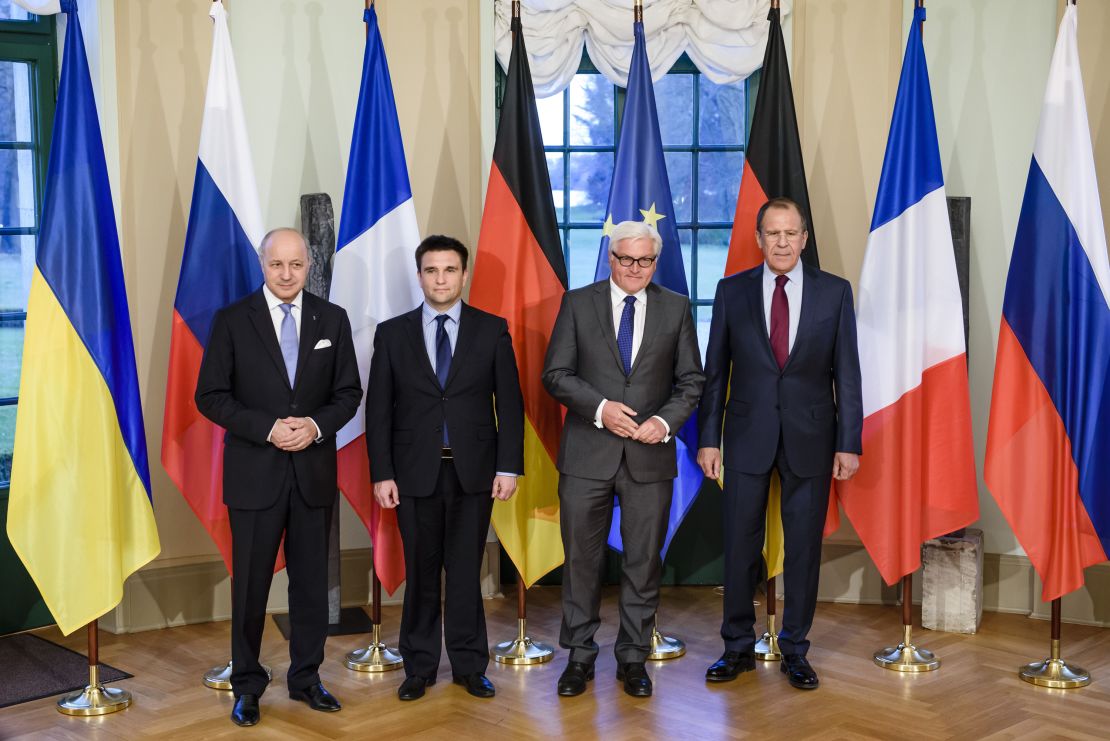CNN
—
The ceasefire proposal put forward by the United States on Tuesday and accepted by Ukraine is part of a plan, said US Secretary of State Marco Rubio, “to end this conflict in a way that’s enduring and sustainable.”
It’s a promise fraught with risk for Ukraine. The last time it signed a peace accord with Russia, 10 years ago this February, it brought only sporadic violence, mounting distrust, and eventually full-scale war.
“I told President Trump about this,” Ukraine’s President Volodymyr Zelensky said in an interview last month with CNN affiliate CNN Turk. “If you can get Putin to end the war, that’s great. But know that he can cheat. He deceived me like that. After the Minsk ceasefire.”
The Minsk accords – the first signed in September 2014 and, when that broke down, a second known as Minsk II just five months later – were designed to end a bloody conflict between Kyiv’s forces and Russian-backed separatists in Donetsk and Luhansk, in Ukraine’s eastern Donbas region. Russia’s Vladimir Putin and Ukraine’s then-leader Petro Poroshenko were signatories, along with the OSCE.
The accords were never fully implemented and violence flared up periodically in the seven years that followed.
Now, as Ukraine and its allies attempt to forge another path to peace, experts warn the failures of Minsk serve as a cautionary tale for today’s peacemakers, and that the risks of history repeating are clear. Here’s what we’ve learned:
In 2015, Western military aid to Ukraine was minimal, and mostly limited to non-lethal supplies, though the Obama administration did supply defensive military equipment. “The crisis cannot be resolved by military means,” said then-German Chancellor Angela Merkel, in a speech at the 2015 Munich Security Conference, which coincided with the talks on Minsk II. Her assessment of those diplomatic efforts was blunt: “It’s unclear whether they’ll succeed.”
It didn’t help that both Minsk accords were signed right after, or during, major military defeats for Ukraine.
The first agreement followed what’s believed to be the deadliest episode of the conflict in the Donbas, at Ilovaisk. In late August 2014, hundreds of Ukrainian troops were killed as they tried to flee the town to avoid encirclement.
Six months later, Minsk II was signed while fierce fighting raged for another Donetsk town, Debaltseve. That battle continued for several days beyond the initial ceasefire deadline.
Marie Dumoulin, a diplomat at the French Embassy in Berlin at the time, says those defeats put both Ukraine and its allies firmly on the back foot in the talks.
“Basically the main goal, both for France and Germany, but also for the Ukrainians, was to end the fighting,” she told CNN. But, she added, “Russia through its proxies, but also directly, was in a much stronger position on the battlefield, and so could increase the intensity of fighting to put additional pressure on the negotiations.”
From a military perspective, Ukraine’s Western-backed, almost million-strong army of today is almost unrecognizable from the underfunded and under-equipped force that took on the Russian-backed separatists in 2014.

And yet, as Ukraine “accepts” a temporary ceasefire proposal, it faces a double challenge.
Firstly, Russia, has been inching forward in recent months on the eastern front (albeit at a huge cost to personnel and equipment), and inflicting almost daily aerial attacks on Ukraine’s cities. And secondly, the US, Ukraine’s biggest backer, has now withheld crucial military aid, in response to a public falling-out between Zelensky and US President Donald Trump. The aid is now restored, but the episode has left Ukraine on shaky ground.
“That makes Ukraine’s situation now very precarious,” said Sabine Fischer, senior fellow at the German Institute for International and Security Affairs. “Ukraine from… the Trump administration’s perspective has become an obstacle to this normalization that they want for their relationship with Russia.”
Experts agree the Minsk accords were put together hastily as violence escalated. Johannes Regenbrecht, a former German civil servant who was involved in the negotiations, pointed out in a recent paper that Ukraine’s allies had reached the point in February 2015 where they worried that allowing Russia to continue unchecked “would have resulted in the de facto secession of eastern Ukraine under Moscow’s control.”
With hindsight, experts say, the resulting document left too much ambiguity when it came to implementing the deal. The thorniest issue was how to link the military provisions (a ceasefire and withdrawal of weapons), with the political ones (local elections, and a “special regime” in the separatist-controlled areas).
“Ukraine was saying, we need security first and then we can implement the political provisions. Russia was saying, once political provisions are implemented, separatists will be satisfied and will stop fighting,” said Dumoulin, now director of the Wider Europe program at the European Council on Foreign Relations. That initial disagreement was an early sign of what Dumoulin and other experts see as Moscow’s ultimate intention to use the political provisions of Minsk to gain greater control over Ukraine.
Fischer argues that Trump’s desire to end the war quickly suggests the US may not only be at risk of reaching a flawed deal in haste, but may actually be willing to settle for something that doesn’t offer long-term solutions. “Comprehensive ceasefire agreements are not negotiated quickly… they’re very complicated, many intricacies… And I don’t think that this is what the Trump administration is aiming for,” she told CNN.

In the end, the biggest issue with the Minsk accords, especially Minsk II, wasn’t what was in the text, but what wasn’t. There’s not one mention of “Russia” in the entire text, despite clear evidence that Russia was both arming the separatists, and sending reinforcements from the Russian army.
“Everyone knew that Russia was involved, but for the sake of the negotiations, this was not recognized,” said Dumoulin. “The agreements were based on the fiction that the war was between separatists in Donetsk and Luhansk and Kyiv, and that it was ultimately a domestic conflict.”
There is no direct parallel today but there is, experts say, a risk Moscow is now using the false narrative that Zelensky is illegitimate because he failed to hold elections – Ukrainian law clearly states elections cannot be held during martial law – to rebrand the war as something that should be solved internally in Ukraine, and ultimately bring about regime change.
And even more concerning for Ukraine is that the US has taken a similar line, with Trump last month labeling Zelensky “a dictator without elections,” although he subsequently appeared to distance himself from that statement.
The failure of the Minsk accords leaves no doubt as to the risks of perpetuating such falsehoods.
Back then, the fiction that Russia wasn’t an aggressor or party to the conflict, along with insufficient pressure on Moscow in the form of sanctions or the provision of lethal military supplies to Ukraine, ultimately meant Minsk never addressed the root cause of the conflict.
“The fundamental contradiction of Minsk,” wrote Regenbrecht, “was that Putin sought to end Ukraine as an independent nation… Consequently, he had no interest in a constructive political process.”
There’s no evidence that that position has changed. In his speech on February 21, 2022, three days before the full-scale invasion, Putin described Ukraine as “an inalienable part of our own history, culture and spiritual space,” before claiming, “Ukraine actually never had stable traditions of real statehood.”
In January this year, one of his closest aides, Nikolai Patrushev, said he couldn’t rule out “that Ukraine will cease to exist at all in the coming year.”
And so, even amid US promises of keeping Ukraine out of NATO, and forcing them to accept territorial losses, the negotiating teams in Saudi Arabia have so far, it seems – just like their predecessors in Minsk – come nowhere close to tackling that core issue.

